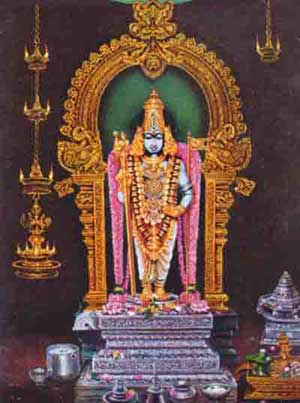
|
|||||||
|
| |||||||
Palani Hill Temple Puja Services
‘More things are wrought by prayer than are dreamt of in our philosophy', said Shakespeare. To enable the devotees to pray to and before the Lord, there are six pujas or services every day. At 5 a.m. the Lord gives the Visvaroopa darshan. The first puja is Vizhāpuja or day's festival at 7.15 followed by Kālasandhi (8 a.m.), Sirukāla Sandhi (9 am.), Uchikkālam (or mid-day service), Sayaraksha (evening service) and Rākkālam. Each service consists of (a) abhishekam (b) offering of food and (c) alankaram. In the Temple of the Emerald Buddha in Bangkok (Thailand), the Buddha's robes are changed thrice a year, in keeping with the hot, cold and wet seasons. Here at Palani, Lord Dandāyudhapani's robes are changed several times a day and it is difficult to keep a count. The deity is decorated and dressed as Prince, hunter, lad and ascetic. At the request of devotees these alankarams are also done during specified intervals on payment of prescribed charges. After the Raja Alankaram at the evening service at 5.40 pm, no abishekams are allowed. The artistry with which the gurukkals do the alankarams and the swiftness with which they present the deity in one alankaram after another deserve praise. The pilgrim is advised to visit the hill temple for Visvarūpa Darshan and for three important services at 12 noon, 5.40 p.m. and 8. p.m. At the Uchikkālam, the rituals are elaborate and the deity is dressed in a conservative and orthodox way. In front of the sanctum sanctorum, each individual has his own assessment of time. A few minutes can be long. An hour can be brief. Time in front of the deity wears many faces and rejoices in the variety of abhishekams which are a joy to watch. Indeed, they are a feast to the senses. This is the order in which various materials are used to anoint Lord Dandāyudhapani:
In all the Siva temples, Panchopacharams are performed. These include sprinkling of holy water, spraying of scented ointment, offering of flower, burning of incense powder and finally showing ‘Harathi'. In this temple alone, these are preceded by elaborate abhishekams. RākkālamRākkālam or the last puja for the day commences at 8 p.m. with abhishekam. The deity is dressed in large quantities of sandal paste which remain overnight. Early morning they are removed; medicinal value accrues to the paste throughout the night and it is utilised to maximum advantage by the devotees. The menu for the last puja is called Tinai, a cereal grain powdered and mixed with Kandasari sugar. March to Palli AraiThe next item in the temple ritual is the ceremonial procession to the Palli Arai. When this is over, the temple staff call it a day! In other temples, Palli Arai is the bedroom of the Lord, i.e. the chamber of His spouse. Here the Lord is a child with no family tie. His spouse or spouses are nowhere in the hill temple. The Moolavar (immovable deity) stays where He is. As His representative, His footsteps are taken ceremonially. The Oduvar and the Kattiyakkarar recite passages from the scriptures. Then a silver palanquin is brought to the doors of the sanctum sanctorum and the footsteps placed on it. On Fridays, Mondays and Kārttikai a golden palanquin is put into use; on these days, the procession route includes the outer prakaram too. The edible part of the coconut is mixed with jaggery and cardamom and distributed to the devotees. A green carpet is spread in the route and the palanquin carried to the Palli Arai accompanied by Nadasvaram music, Theevattis and fly-wisks called Ven Chāmarai. The footsteps are transferred to a swing that is like a cradle. The theory is that Muruga came to Palani as a child and so He is put to sleep in a cradle as any other child. The day's receipts and expenditures (classified under each head of account) for the hill-temple are read at the Palli Arai in the presence of all the devotees. With the Oduvar and the Kattiyakkarar singing lullabies glorifying the Lord, the doors of the Palli Arai are locked, the pilgrims cleared from the hill and the entire temple sealed. On Sashti (sixth day after new moon and sixth day after full moon) and on Kārttikai days, there are special services and large crowds gather. If these days happen to be public holidays, the number of devotees may be between fifty thousand and one hundred thousand and you will have to inch your way to the sanctum sanctorum to have a darshan of the Lord. The main shrine was perhaps built in the Seventh Century AD by a ruler of Kerala, King Cheraman Perumal. His figure on horseback is inscribed in stone near the Vairava sub-shrine in the exterior of the northern wall of the sanctum sanctorum. The Navaranga Mandapam is a stone structure with four pillars surrounding the central one and making nine bays in all and is a gift of the Nayaks. We owe the other portions of the temple to Pandyas, a number of local chieftains and to religious-minded social groups and individual devotees of a rare calibre. Long-conditioned by a philosophy of self-abnegation, the men who built this temple (and other temples in Tamil Nadu) and carved their details rarely announced their names.
|
